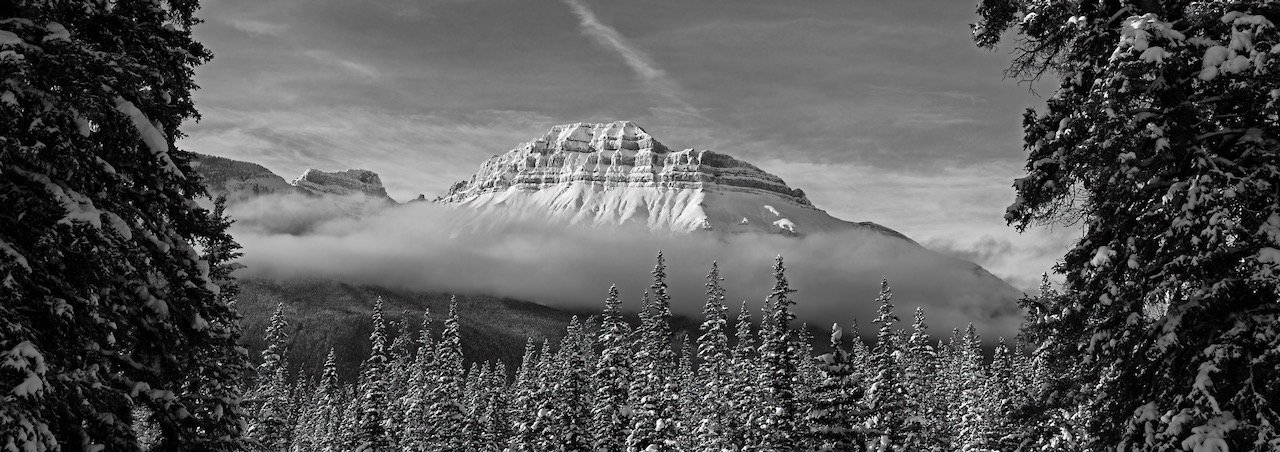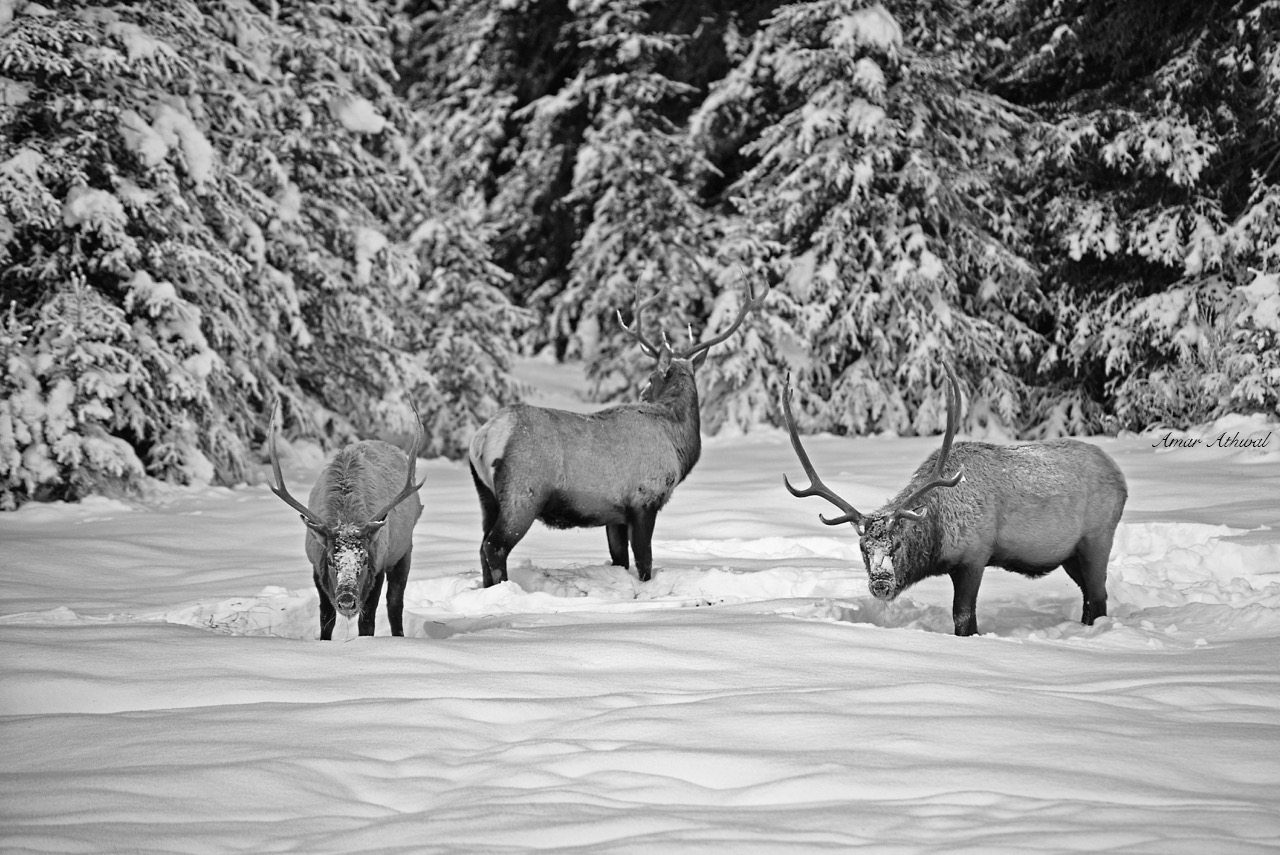When I’m out to take pictures of wildlife, I’m hoping for clear weather with good lighting. But under the same weather for landscape photography, the camera stays in the bag. You do not just want to take pictures of the mountains, but also the mood created by the combination of the landscape, clouds, shadows, and light. The more time you spend taking pictures, the more refined your style becomes. I’m finding it now, particularly when it comes to landscape photography. Well, even when it comes to flora and fauna, certain conditions must be met before the camera comes out. Photography is like any other skill in life. Over time, you start getting a better sense of what the final image is going to look like before you even take the picture. If you know the image will be good, you take the picture. And if you are unsure, you might take the image. For the rest of the situations, the camera stays put and you keep moving. Otherwise, you are not going to get far on a hike.
Mount Aberdeen
We humans have already figured out how to make time go by quickly. You just have to stay busy. It feels like this picture was taken just a couple of weeks ago. But when I looked at the date, it was the start of October. I was coming down from the Big Beehive using a safer route, still above the low clouds that were in the Lake Louise area. On the way up early that morning, I heard a Northern Pygmy Owl. But there was still not enough light to explore to see if I could see it. So, descending a different route, I was not going to have a chance at possibly seeing the owl. But the great views more than made up for that. For some of the views, I just had to stop and take my camera out to get their pictures. This one was one of them. The trees in front of me and Mount Aberdeen were all covered with fresh snow. It was a winter wonderland on the morning of October 1, 2023.
Pilot Mtn
The day before ended with a great sunset, the sky was lit in all directions. Many of us got to enjoy nature’s light show. In the morning all conditions pointed to a bright sunrise to the east. With the day off, I decided I wanted to get a picture elsewhere. Challenging myself to try something different for creativity, which in the end is great for the mind and improves landscape photography as a whole. I still enjoy going to the popular places to take pictures, but getting something different, even of a mountain I have taken pictures of before, is a little extra special. As well, I have been having fun trying to get images in the more traditional panoramic aspect ratio of 6x17. Not simply taking a picture and then seeing if this ratio for cropping works, but having the cropping ratio in mind before taking the picture. Thanks to the low clouds and everything being covered with snow, this black and white image worked out well as a panorama.
Ice Bubbles
On our favourite planet Earth, 71 percent if its surface is covered by water. The oceans contain 97 percent of the water and the remaining 3 percent is fresh water contained in lakes, rivers and ice. Two Hydrogen atoms and one Oxygen atom make up one molecule of water. The molecules are always moving because of potential energy. Water molecules have more energy in liquid form than in a solid state. Potential energy is reduced as the water cools down, the molecules start to move slower. When the water temperature reaches zero degrees Celsius, the molecules stick together to form a solid, which is ice. In the solid state molecules are still moving, we just can’t see it with our naked eyes. For water to turn into ice, we still need more than cold temperatures. A small impurity, from the impurity or particle will grow an ice crystal. Without impurities in water, say in pure water, water will not freeze, even when reaching minus 40 degrees Celsius. This process, called super cooling, occurs when pure water is contained in a smooth container.
But, I was not thinking about this when I came across this creek, which in metric would be called 64.37 Kilometer Creek. After seeing clear ice with nice bubble formations. I needed to decide if it was thick enough to hold my weight. After a few minutes of observing, I felt it was safe and decided slowly to move to the bubbles and get the picture.
Massive Range
On a cold morning I started walking on the Bow Valley Parkway. A section of the road that saw a lot of hikers and bikers over the summer, as it was closed to the vehicles as part of the COVID 19 restrictions. Walking is my preference when nature photography is on the mind, on foot I can see and hear more of what’s around me and quickly stop to take out the camera and hopefully get the picture. I picked up my pace to get the body warmed up. About a kilometre in I had to remove a layer. I have driven on this road more times than I can count, I tend to avoid the Trans Canada Highway, more to enjoy when the goal is not get from point A to b as fast as you can.
Not being on the BVP for over six months, it felt good walking on it. I know every section of the road and areas I like to explore by foot. I was making good time. There were various tracks in the snow and other evidence of wildlife that had moved through the areas I was walking by. Stopped to take pictures of birds I came across and others like the Bald Eagle, I just watched as it flew well above me. I came across grizzly bear tracks, it was heading in the same direction as me but about 24 hours ahead. I had some idea which large male it might be, a few hours later it was confirmed. But that’s a story for another time.
I was looking at the Massive Range, getting different views as I walked west on the road. The light was great and the snow covered peaks were hard to look away from. With the lack of wind that morning, my hope was to reach a certain bend in the Bow River, where if conditions stayed the same, it would provide me with the picture I wanted. I got there, the water was calm, I was looking at a beautiful fall landscape scene in front of me, which I thought would look great in black and white.
Mount Temple
It was a cold morning, temperature below minus 30. As soon as I stepped out the face quickly confirmed it. With short winter days you have to take advantage of the days off, the plan was to go for a drive and do short hikes and then a longer hike closer to home. It was mainly overcast, light sneaking through here and there. I stopped at few places to have a look and take the odd picture. I passed the same vehicle few times, each time it was parked middle of the road, windows closed and the driver taking pictures of the beautiful winter wonderland. I almost wanted to stop and let them know they would be fine if they stepped out and took a picture from outside the car. But instead I nodded as I passed them, no one else was out. On my last stop I had a short walk though the snow to find the right amount of trees and height for the foreground to get the picture I wanted.
Elk
Relatively speaking, it started out easier for the elk this winter. Not as cold and less snow on the ground. They still had to eat the same less nutritious food, no greens in the winter. But less snow to move aside to get at the food and less energy needed to get through the milder days and nights. But all that changed, snow storms started to come through and February brought with it much colder temperatures. Just like these three bulls, they have to spend more energy moving lots more snow to get at the less nutritious food and as well, losing lots more energy to survive the colder days and nights. Until spring arrives, they will be getting weaker, while their predators get stronger.






